Adjusting to Lingual Braces

There are four main types of braces that include traditional metal braces, ceramic braces, lingual and Invisalign treatment. When patients want sturdy metal for effective straightening power, but they don’t want visible metal, lingual braces is the option to choose. This consists of an orthodontic appliance attached to the back of the teeth. With any orthodontic appliance attached to the teeth, there will be an adjustment period for patients.
Why Get Braces?
Many people wonder why they would need orthodontic treatment if they are already seeing a dentist. However, a dentist is not the same as an orthodontist. Both have gone to dental school, but only an orthodontist can correct bite and alignment issues that would cause oral health diseases, problems with speech and issues with eating. Straighter teeth are teeth that are easier to clean, helping you avoid oral health diseases.
The teeth are less likely to crack, chip, fracture or break from uneven biting pressure when they are straighter. Studies show that people who straighten their teeth often feel more attractive, confident and motivated, and others view them that way as well. Braces can not only help reduce your risk of oral health problems (or help them to go away), but they can make you feel like a million bucks from the beautiful smile you receive.
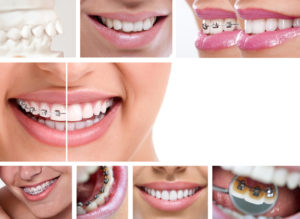
What Are Your Options?
In the past, traditional metal braces were the only braces option patients could get. Today, there are four main orthodontic options. Those include:
- Traditional Metal Braces – These are the classic metal bracket and wire option that is most commonly chosen by patients. Patients who chose this option come in to have their wires tightened at each appointment.
- Ceramic Braces – These braces are a close cousin to metal braces. They have the same bracket and wire design of metal braces, except that they are made out of ceramic material. This helps decrease demineralization during your orthodontic treatment. Ceramic material is also naturally white, helping these braces to blend in with your teeth more than metal would.
- Lingual Braces – These are metal braces that are placed on the back of your teeth. Instead of just a square bracket, the metal must be custom-made to the shape of the back of your teeth. This is a discrete option that adults and teens love.
- Invisalign Treatment – This is the most invisible option available to our patients. Invisalign is a series of transparent aligners that you wear at night and throughout the day. You can remove them for eating, playing sports, cleaning your teeth and more.
Adjusting to Lingual Braces and More
For many patients, the adjustment period with their orthodontic appliance will be a new experience. Getting braces on the teeth is a new and exciting chapter for anyone that is starting on their journey to a better smile. However, your mouth does have to physically adjust to orthodontic appliances. With traditional metal, ceramic, or lingual braces, there are orthodontic parts that will be bonded to the teeth with a cement-like bonding material.
The application of that bonding material with your teeth will place extra pressure on them for several days. You may have to take an over-the-counter painkiller (like Tylenol) to help ease that aching feeling. Soft foods like yogurt or pasta will be better after the braces application for sensitive teeth. Your tongue will have to adjust to orthodontic appliances as well. For traditional metal braces on the front of your teeth, they may feel bulky as they rest against your lips.
With lingual braces, your tongue may feel more crowded or may constantly run into the brackets. With both of these options, a patient’s mouth becomes used to the appliances so quickly that they won’t even notice the braces after a few days. Your smile won’t look bulky with your appliance, but it will start to look straighter over time. Cleaning your teeth will take a bit more work, but this too will become second nature to you. With each new braces adjustment, your teeth may feel a bit sore, but that feeling will go away quickly.

Keeping Your Smile Healthy
You can spend 18 or more months straightening your teeth, only to have them be decayed at the end of your treatment. However, this doesn’t have to happen if you are taking meticulous care of your teeth with braces on them. Patients should be brushing and flossing their teeth whether or not they have braces on them. The American Dental Association recommends that every person brush their teeth at least twice a day. With braces, you want to brush them very well after every meal to dislodge food that would cause decay.
Flossing is key as well, as flossing gets about 40% of your tooth surfaces that brushing misses. If you skip flossing all the time, all those tooth surfaces can decay. With braces, you won’t be able to do the normal flossing you’re used to. Lingual braces can be even harder if you can’t see where you are flossing. This is where flossing tools for braces come in handy. Invest in threadable floss or flossers (which is very similar). This is floss that you stick through the cracks in your teeth and pull through like a sewing needle. You floss the tooth, scraping the teeth as you go, and pull the floss all the way through the tooth to start on a new one. It only takes a minute or so more than normal flossing, but will help prevent decay with your lingual braces.
Braces Are an Investment
Your teeth may take a bit more time to keep clean with braces on them than they were before. However, with braces such as lingual braces, you’re making your smile straighter and more beautiful for years to come. That straightness will not only help make cleaning the teeth easier for years, but it will help your appearance and your confidence. If you want all the benefits of a beautiful, straight smile, call Belmar Orthodontics today at (303) 225-9016!
Child Orthodontics Compared to Adult Orthodontics
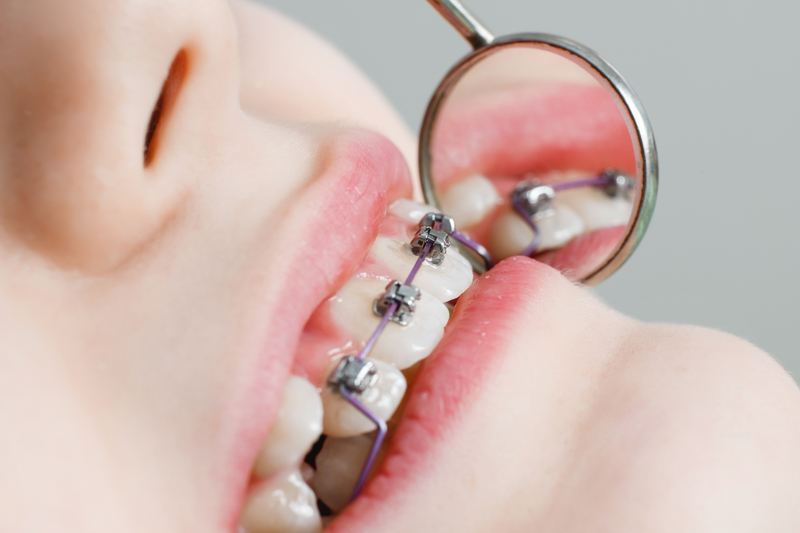
Did you know that about 1/4th of all people with braces are children? Millions of Americans receive orthodontic treatment for bite and alignment correction and for straightening the teeth. However, adults require treatment differently and for longer than a child would need, and child orthodontics have different goals for patients than adult orthodontics do. Both of these areas of orthodontics differ, but are also very similar in techniques used to create a beautiful smile.
Orthodontic Treatment
Orthodontic treatment is one of the easiest ways to help improve your health. Braces can help correct major oral health problems and can help avoid dental emergencies in the future. In children and adults, braces straighten the teeth so that they are aligned properly for speech, eating, biting and more. Straighter teeth are easier to clean and easier to manage, which leads to better health. Teeth must come in at specific places in the mouth for both children and adults. Child orthodontics focuses on that proper bite and tooth placement, and adult orthodontics seeks to improve the look of a smile.
Child Orthodontics
Did you know that children often wear braces, only to get them again as adolescents? Child orthodontics is a popular orthodontic option for at least 1/4th of braces wearers. Dentistry has been around enough centuries to know that the teeth, bite, alignment and growth happen in a specific way. Teeth must come in at the right spot and must be aligned in a specific manner in the jaw. As a child begins to get their baby teeth, some may be crooked. Depending on oral health conditions, and problems such as thumb-sucking, the shape of the teeth and bite can change.
Some children will have teeth that protrude outward, inward, or teeth that are in various directions. This leaves them open to the risk of broken or fractured teeth, tooth decay and problems with speech and development. Child orthodontics is the first phase of getting braces early. It focuses on getting the jaws lined up correctly and the teeth resting on each other in the right way. Once that happens, the baby teeth can fall out and the adult teeth can smoothly come into place. Child orthodontics will correct the major issues a child’s mouth has when they are around 7 or 8 years old. Starting at 11 and later, braces will seek to make the teeth look more attractive.
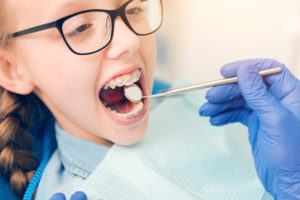
Adult Orthodontics
Most people think that teens make up the majority of patients with braces. However, adult orthodontics is very popular as well, with about 1/4th of all orthodontic patients being adults. There are more adults wearing orthodontic appliances than you realize, especially because of the “invisible options” they have that children don’t have.
Adults have a harder time with straightening their teeth than children do. By adulthood, the mouth and jaws have stopped growing, making them less moldable than a child’s jaws. The treatment that would have been easy for a child may take twice as long for an adult, or may require surgical orthodontics to achieve a straight smile, or proper bite and alignment. However, adults get the benefits of Invisalign treatment and lingual braces, which most children can’t have.
Invisalign is an “invisible” straightening option for adults and teens that uses a strong, clear aligner to straighten the teeth. Digital scanning creates customized aligners that a patient changes out ever 1-2 weeks, which slowly shift the teeth into their proper place. This invisible option allows adults and teens to brush, floss, eat and play sports without brackets and wires in the way. Lingual braces is another “invisible” straightening option. It has metal brackets and wires, except they’re placed on the back of the teeth. Only an adult can use these, as the baby teeth are not large enough for lingual braces to fit. Both adult orthodontics and child orthodontics correct bite, alignment and tooth issues, but the options available to the two age groups differ slightly.
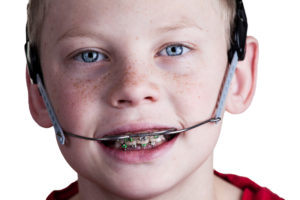
Why Choose Either Option?
When considering orthodontic treatment, there are various aspects you have to think about that include cost, health changes, aesthetic appeal and more. Many people think that braces are very expensive, when they are actually quite affordable. Your family may even save more money over time because of the oral health problems that are avoided by proper orthodontic treatment. A major reason so many people have orthodontic treatment is that they want to improve their smiles. Not only does a straight smile look beautiful, but it helps patients feel more confident. Studies show that child orthodontics helps children feel more confident in school and they do better academically.
Braces can correct speech problems caused by bite and alignment issues. They can straighten the teeth, making them easier to clean, and thus reducing problems with tooth decay, gum disease and bad breath. People socially perceive patients in a more positive way if their smiles are straighter and healthier. No matter if you choose orthodontic treatment for aesthetic appeal or for health reasons, the benefits are worth the time, effort and money you put into your treatment.
Conservative Treatment
Dr. Hardy practices a conservative approach to orthodontic treatment. While it is important for children to have an early orthodontic assessment to look for serious dental concerns (around age 7), the majority of children will not require orthodontic treatment before age 11. Your child might need child orthodontics or they may only need orthodontic treatment as a teen. Some people are naturally born with straight teeth that don’t pose them a problem, or their teeth start to shift later on in life. Whether your child needs child orthodontics or you need adult orthodontics, call Belmar Orthodontics today at (303) 225-9016 for your free consultation!
Orthodontic Treatment Before the Year 2000
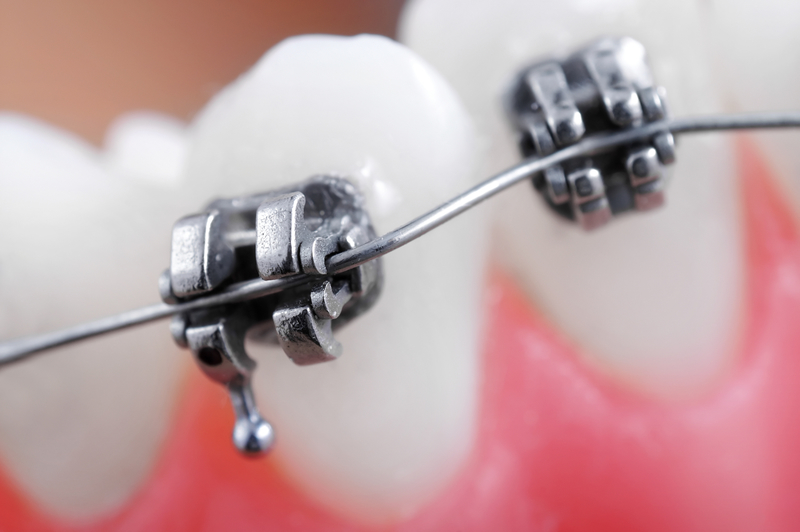
It’s the year 2018 and a lot has changed in every field of medicine since the year 2000. Orthodontics is no exception, and there are always new advances in how your teeth are straightened and cared for. There are many braces options available to patients that were not available in years past. However, some services—such as Invisalign—have been around longer than you might think. Find out when different orthodontic practices and services were available to patients and how orthodontic treatment looked before the year 2000.
How Old Is Orthodontic Treatment?
Many people think that orthodontic treatment is fairly new. However, people have been straightening their teeth for many centuries. Their methods were simply much cruder than the braces and orthodontic appliances you know today. Many mummies from Ancient Egypt have been found wearing orthodontic appliances to straighten their teeth. Ancient Greeks, Romans and the Etruscans have also been found with various types of “braces” and other mouth appliances.
To give you an idea of how long orthodontic treatment has been around, writings by Hippocrates (a Greek physician) have been found about the subject from 400 b.c. Even back then people were concerned about crooked teeth and how they looked. However, there weren’t very good methods for straightening the teeth, so there weren’t many advances in orthodontics until just a few centuries and decades ago.

Past Orthodontic Methods
People centuries ago did not have the best methods for straightening teeth. However, over the centuries, many people made advances or tried various methods such as the following:
- Ancient Egyptians used metal parts and wires to try to straighten the teeth, as has been seen on mummies.
- Celsus, a Roman writer from around 1 A.D., wrote about trying to straighten your teeth by pushing them into place.
- Several years later, a Roman named Pliny recommended filing your teeth down if you wanted them a certain size.
- Pierre Fauchard was born in 1728, and through his various methods and research in straightening teeth, is now considered the “Father of Dentistry”. One of the methods he tried on patients was forcefully pulling and moving the teeth into place with forceps. He would then tie those moved teeth to others so they could heal back into the mouth again.
- Dental impressions began in the 17th century by Matthaeus Gottfried Purmann. Impressions make models of the teeth, and this method was so successful that impressions are still used today.
- In the United States, barbers and medical doctors often pulled infected teeth and performed orthodontic treatment. The treatment varied from person to person and generally involved pulling teeth without numbing medicine.
- J.S. Gunnell invented a form of headgear in 1822 that was successful in straightening the teeth. However, that headgear was large and fastened to the jaw outside the mouth and pushed on the teeth.
- Before 1970, professionals in orthodontics wrapped wires around each tooth, anchoring them with a bracket on each tooth. This method required a lot of metal in the mouth.

Modern Braces and Appliances
Modern orthodontic treatment is very straightforward and easy. Orthodontics has advanced so much that people can even straighten their teeth without any visible signs that they are doing so. When you think of braces, you probably think of the metal brackets and wires that so many wear. Traditional metal braces consist of a metal bracket attached to each tooth with a metal wire going through the bracket. This orthodontic treatment method mimics past metal treatments that were done throughout the centuries. However, the brackets and wires take up minimal space in the mouth and gently straighten the teeth.
Ceramic braces are another modern option for patients that are most similar to metal braces. They involve the same look and design, except they are made from white, ceramic material. Even the archwire can be made white for a patient. Lingual braces also use a metal bracket and wire design, except that they are attached to the back of a patient’s teeth. These were created in 1976 and provided patients with a way to straighten their teeth without visible brackets on their teeth.
Invisalign is the most incognito way to straighten your teeth. Created in 1997, this orthodontic treatment consists of transparent aligners that are switched out each week. A patient will wear the aligners 20-22 hours a day with the freedom to remove them for eating, drinking, sports, playing instruments and more. In about the same time as traditional metal braces (sometimes less), patients can get straight teeth. This is an amazing option, as any teen or adult can straighten their teeth without others knowing.
Orthodontic Treatment Today
Many advances in dentistry happened around 1970 and later. This is when the design of metal braces was perfected to what we know it to be now. The future will surely hold many more advances in orthodontic treatment as the years go by. No matter what type of appliance is available or what you choose to have, we recommend straightening your teeth. Not only can it significantly reduce your risk for tooth decay and gum disease, but straighter teeth can raise your confidence and help you be more successful. To have your free braces consultation, call Belmar Orthodontics today at (303) 225-9016!
What To Do About Your Wisdom Teeth
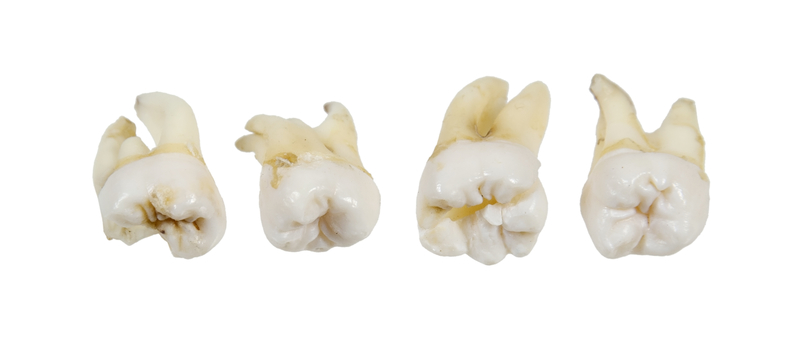
The wisdom teeth are back molars that, on average, come in between the ages of 17 and 21. Wisdom teeth can put pressure on the rest of your teeth and make them crooked if something isn’t done about them. You don’t want wisdom teeth to undo all the hard work you spent getting your teeth straight. Find out how wisdom teeth affect your oral health and what to do about them if you are planning on getting braces or if you just got them off!
Your Permanent Teeth
Every person gets two sets of teeth during their lifetime: the baby teeth and the permanent teeth. If you are reading this, then you have already likely lost all your baby teeth. That means you are left with your permanent, adult teeth, which you will have for the rest of your life. Well, at least most of them. The majority of Americans get their wisdom teeth removed to help keep their mouth healthier. You have several sets of large teeth in your mouth, which are called the molars. These are the bigger teeth towards the back of your mouth that help you chew up food.
Most people have all of their permanent teeth by their early teen years. However, there are up to 4 teeth that come into the mouth later on, usually between the ages of 17 and 21. These are the wisdom teeth, and no they are not teeth that provide you with your wisdom. These are a third set of molars that come in as you transition from a young adult to an adult. As a people, we don’t really use these third molars, but our ancestors in centuries past may have had much more use for them when it came to chewing meat.
However, one of the reasons they are called the “wisdom teeth” is because this transitioning stage from young adulthood to adulthood. This is generally a time when people rapidly mature and make many life changes, which helps increase their wisdom. Hence, the “wisdom teeth”.
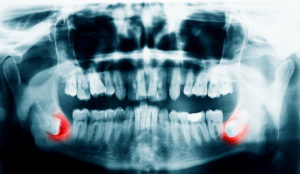
What to Do About the Wisdom Teeth?
As mentioned, we don’t really use these third molars in our day. In fact, the wisdom teeth can actually cause your smile more harm than good. They come into your mouth at an angle, which can put pressure on your closest molars. The wisdom teeth can push those molars, causing all the teeth to start pushing into each other. This creates a crooked smile. The pressure and angles of these wisdom teeth coming in can weaken the second molars or crack them. When the wisdom teeth start coming into the mouth at an angle, they are called “impacted teeth”.
Generally, the wisdom teeth crowding or damaging your teeth isn’t painful. However, if you develop tooth decay because of the wisdom teeth, and it gets severe, then you will feel pain. Some patients will have the wisdom teeth sit right underneath a layer of gum tissue. That this layer can collect bacteria and food particles, which can actually lead to an infection in your mouth, which you don’t want. Other patients also have bone or other teeth blocking the wisdom teeth, so they will never come in very well and will really damage your smile. Hence, the reason why they are so often taken out. You don’t really need them and they generally cause mostly problems instead of benefits.
What Is Surgical Orthodontics?
Many people are born with 4 wisdom teeth. However, depending on genetics, some people may only have 1, 2 or 3 wisdom teeth or even none at all. It all depends on the genetics you have. Some will have them only in their top jaw or only in the bottom jaw. However, there are so many problems with these teeth that we recommend that they be removed before your smile is affected. Surgical orthodontics and surgical dental procedures can remove the wisdom teeth.
These procedures will either use topical anesthetics or will put a patient completely under to remove the wisdom teeth. We take full x-rays of both the top and lower jaw of your teeth so you can see the angle and trajectory of your incoming wisdom teeth and how they will affect your oral health. Generally, the gums are cut right above where the wisdom teeth lie. Then, they are removed with dental tools and the gum flaps are put back in place and closed up. In just a few weeks, you will feel good as new and you won’t have problems with your wisdom teeth. For such a simple procedure, it’s worth it to protect your smile and to keep it straight.
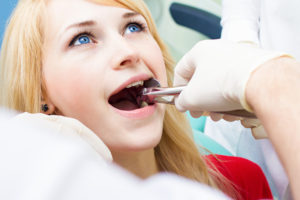
Keeping Your Smile Healthy
Just like any other part of your body, it may take many steps and actions to keep those parts healthy. Your smile is something that takes work to maintain, but luckily it’s not hard work. All you have to do is brush your teeth at least twice a day as recommended by the American Dental Association. They also recommend flossing at least once (if not more), using mouthwash and fluoride products, and seeing your dental professional often.
These things don’t take much time and effort, but those small actions can save your smile and keep it healthy and straight throughout life. If you need tips for keeping your mouth healthy or you want to know more about what you should do with your wisdom teeth removal, call Belmar Orthodontics today at (303) 225-9016!
The Best Ages for Having Braces

If you have a desire to get braces, we commend you for choosing to have a better smile! Studies show that a better, straighter smile can increase your confidence, success and professional life. However, there are some key ages that having braces are the best for patients. If you have bite and alignment issues, it’s best to receive child orthodontics. For straightening, the teenage years are the best for wearing having braces. However, braces can benefit patients at any age and may even be needed more than once in life. Find out what orthodontic treatment can do for you at any age!
Child Orthodontics
The American Association of Orthodontics recommends that children have their first orthodontic visit between the ages of 7 and 8. Having and examination early as a child will detect bite and alignment issues that can become severe later on in life. This early visit is something that you definitely want your child to receive, as bite and alignment issues can lead to problems with speech. If the baby teeth are misaligned, then the adult, permanent teeth will come in misaligned as well. This will eventually lead to cracked, chipped or broken teeth when chewing and biting, as different teeth will take on different amounts of pressure.
There are several different types of bite problems children can have. One is crossbite, where one or more teeth are turned either in towards the tongue or out towards the cheek. Overbite is when the upper teeth overlap the lower teeth too much. Underbite is when the lower front teeth overlap the upper front teeth. In a healthy smile, the upper front teeth will rest on top of (and just a tiny bit forward) of the lower front teeth. If your child does have a bite or alignment problem, it’s easiest to fix while they are young, as the jaw is still growing and forming. Between 7 and 8 years old is the best time for having braces as a child to correct this problem.

Adult Orthodontics
Having braces as a teenager can vary depending on when all the permanent teeth come in. Once the permanent teeth have come in (somewhere around age 12), a child should be seen for a consultation. This is great time to straighten the teeth as the jaw is still growing. However, later in the teenage years and afterwards, the jaw will stop growing and straightening the teeth becomes harder. That is why the teenage years are the best to straighten a child’s teeth. Not only will having braces straighten crooked teeth, but they can also help your child have more confidence because they will produce a beautiful, straight smile after treatment. Straighter teeth are proven to boost confidence in children, teens and adults alike.
Adults benefit from receiving braces at any age. Even though the jaw has stopped forming, it’s never too late to get braces (except if you are in later years and losing your teeth). About 25% of people who have braces are adults. Getting a straighter teeth can boost your confidence and social life. Studies show that employers also hire someone with straight teeth over someone with crooked teeth. Other studies show that people find you more attractive, trustworthy, and datable if you have straight teeth.
Braces Options
Your options for braces will vary slightly depending on your age. In the past, traditional metal braces were your only option for straightening your teeth. This option is the one that has metal brackets attached to the center part of your teeth with a metal wire that goes through them on top and bottom. Metal braces aren’t your only option for treatment. For children, metal and ceramic braces are the best choices and the most economical. Ceramic braces mimic metal braces and have brackets and wires. However, instead of metal, these appliances are made from ceramic material, which matches the natural whiteness of your teeth. This is why they are sometimes known as “clear braces”.
For a more discreet look, lingual braces are also an option for adults. These are metal braces worn on the back of the teeth and custom-fitted to each tooth. However, the most discreet option for having braces is Invisalign. This is a series of transparent aligners that we custom-make for your mouth. You switch out the aligners every week and watch as your smile transforms. The best part about this option is that you can remove the aligners for eating, drinking, brushing your teeth, sports and more.

A Beautiful Smile at Any Age
No matter what option you choose, we know you will love the smile you’ll receive by having braces. Braces are not solely for children or teenagers, but also for adults. It doesn’t matter if you are 7 or 57; braces are great for patients at any age! Having braces will significantly reduce your risk for tooth decay and gum disease as well as broken, cracked or chipped teeth. They can get you ahead in life by helping you feel and appear more confident and successful. To answer the question about the best ages for braces, we say the best time is now! To learn more about what to expect with braces, call Belmar Orthodontics today at (303) 225-9016!
Receiving Dental Care with Braces
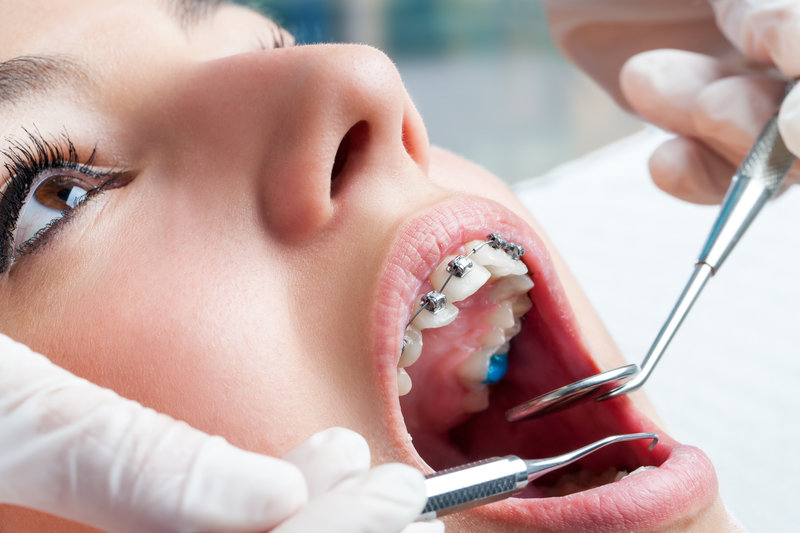
Dentist hands working on young teen patient with dental braces.
Should you receive dental care with braces or is seeing the orthodontist sufficient? Continue regular checkups with your dentist even if you are frequently seeing your orthodontist. Braces make you more prone to problems such as plaque buildup and tartar. Depending on the kind of braces you choose, your teeth may require additional steps to stay clean with braces than without. For some, the enamel can also weaken with braces. However, there are ways to keep your teeth healthy and clean while you have braces. Modern-day orthodontics offers treatment options everyone can be comfortable with and will still allow patients to receive proper dental care at the same time. We can answer frequently asked questions for receiving dental care with braces and help you with tips for taking care of your braces so your smile stays healthy.
Dentists and Orthodontists
Did you know that orthodontists attend dental school just like dentists do? Dentists and orthodontists are similar in their schooling up to a point. However, although both professions deal with the health of your teeth, they both do separate services. Dentists perform services such as:
- Comprehensive exams and diagnostic x-rays
- Dental cleanings
- Oral cancer screening
- Laser tissue treatment
- Periodontal treatment/Scaling and root planing
- Dental sealants
- Cavity fillings/Tooth colored fillings
- Sedation dentistry
- Porcelain veneers and crowns
- Cosmetic bonding
- Dental bridges and dental implants
- Root canal therapy
- Teeth whitening
An orthodontist performs other services different than a dentist, although they are skilled in dental practices. Orthodontists receive 4 years of undergraduate education, where they then attend dental school for 4 years. After dental school, they attend a postdoctoral program to learn orthodontia. A dentist fixes problems with your teeth in general, while an orthodontist fixes problems with teeth alignment as well as your bite and jaw alignment. Basically, every orthodontist is a dentist, but not every dentist is an orthodontist. Patients benefit from having both a dentist and an orthodontist to maintain a healthy mouth.
Caring for Your Teeth
Taking care of your teeth is a bit different with braces than it was without them. During your orthodontic treatment, it is particularly important to maintain good oral health through proper oral hygiene. Brackets and wires in your mouth make it much easier for food particles to get stuck. When those food particles are not removed, it leads to other dental issues like tooth decay (cavities) and gum disease. Your teeth may also demineralize or erode in the areas where your brackets were attacked to the teeth. Areas on the enamel surface lose minerals in this case, which is what causes white squares to form on the teeth. If you drink beverages that stain the teeth easily, you might be left with uneven stains once the brackets have been removed.
With braces, you should still follow the American Dental Association’s recommendation to brush the teeth at least twice a day. We recommend that you brush the teeth much more than that, as food particles can get stuck in the brackets at every single meal. Make sure to avoid hard foods like hard candies, chips, apples, nuts, popcorn and more with your brackets. Also avoid sticky foods such as gum, caramel, taffy, tootsie rolls, and gummies as these foods are much harder to get out of all the small areas of your braces. A lot of caring for your braces is watching what you eat and then cleaning the teeth often after you do eat.
Cleaning with Braces
Flossing is one of the daily tasks that will be more difficult with braces because there is an archwire that blocks the floss from going in and out of the spaces between the teeth with ease. The solution for this is to use threadable floss or a floss threader. With a floss threader, you use regular floss and thread it through the eye of the threader much like you would with a sewing needle and thread. You then floss the threader between each tooth individually. Floss that comes threadable will be harder at one end and will be able to be threaded between the teeth without having to have a separate threader.
After brushing with a toothbrush, you can also use a proxabrush, which looks like a small Christmas tree brush. You place this proxabrush between two brackets, below the archwire, and you brush up and down. This will get food that is hard-stuck in your brackets. Brushing after every meal will reduce how much food gets into your bracket and stays there.
Dental Care with Braces
Even though you are seeing an orthodontist frequently, you must continue to visit your dentist throughout your care! An orthodontist will get your teeth straight, but you receive dental cleanings, comprehensive exams, and cavity care from a dentist, not an orthodontist. Both professions deal with the teeth, but they both deal differently with the teeth. Only a dentist can find cavities and fill them for you. A dentist can provide all the services we listed above, which are all very important to keep the teeth healthy. Receiving frequent dental exams and cleanings are some of the best dental services you can receive while wearing braces, because keeping the teeth clean and free of cavities will help your smile be that much more beautiful in the end.
Schedule a Dental Visit
Your tooth enamel can suffer permanent damage if you don’t take extra care with your teeth with braces. That’s why it’s even more important to receive dental care while you have braces. Be vigilant with your oral hygiene every single day. Don’t skip days! You are spending months of your life to receive a straighter smile. You want that smile to also be a beautiful one at the end of your treatment. In the end, it is very important to receive dental care during braces and to take care of them yourself every day at home. If you have questions about caring for your braces, call our Belmar Orthodontics office today at (303) 225-9016.
No Need to Fear Orthodontic Treatment!

When it comes to straightening your teeth, braces are actually quite fun to wear! You don’t need to fear orthodontic treatment, even if you’re just a child. There are about 4.5 million people each year that wear braces. A large part of those are teenagers, but at least 1/4th are adults and many more are children. Most patients find that they actually like braces and all the benefits they bring to their smile. Orthodontic treatment can actually make your teeth prettier, easier to clean and can help you in so many ways throughout your life. Find out just how fun (and healthy) orthodontic treatment can be for you and why you should invest in it today!
Braces Make You More Confident
Some patients may fear orthodontic treatment (a.k.a braces) because they think they’ll look childish, or they’ll have a mouth full of metal. Others fear the unknown. Technology has come a long way in year past, allowing patients more options for straightening their teeth. You can choose to have traditional metal braces that you can dress up with color bands. However, you can also choose ceramic braces that blend in with the white of your teeth. There are also stealthy ways to straighten your pearly whites with lingual braces that are worn on the inside of the teeth. Invisalign transparent aligners also allow you to straighten your smile without anyone knowing.
In a study conducted by Invisalign, they found that receiving orthodontic treatment made teens and adults more confident. That confidence helped them to feel more successful and be more successful. In their study, people perceived people to be more attractive, trustworthy, and smarter when they straighten their teeth. Orthodontic treatment is something to be excited about instead of feared because of all the amazing benefits that treatment gives a patient.
Orthodontic Treatment Makes You Healthier
Dentistry and orthodontics are closely related although they are vastly different. Even though an orthodontist won’t correct cavities for you, he can can you prevent them in the first place. Straighter teeth are teeth that have fewer cavities than teeth that are crooked. Why? When the teeth are crooked, they are much harder to clean. The American Dental Association recommends brushing the teeth at least twice a day and flossing every single day. What if your teeth are so crooked that you can’t floss between them? What if you can’t reach certain areas to brush away the plaque that builds up every day?
Tooth decay is what happens when you don’t keep the teeth clean and free of plaque. Plaque is a sticky, acidic substance that erodes away your tooth enamel. Every time you eat or drink, sugar mixes with bacteria in the mouth to form plaque, which eats away at your teeth. If you can’t clean the teeth properly, you’ll soon have tooth decay all over. Straightening the teeth will instantly lower your risk for cavities and oral issues. Even children receive braces for bite and alignment problems while they are young to prevent the progression of problems that can become severe later on.
Children and Braces
Children younger than 10 often wear braces. Why? There is usually a problem with bite or alignment that needs to be corrected. Why don’t we correct those issues later on in life? Studies have found that the jaw continues to grow a few years into adolescence. Bite and alignment problems are common in many children. Because the jaw is still forming for so many years, it’s easier to correct bite and alignment when a child is young.
We can bring a child’s bite into correct placement with simple orthodontic treatment. When a person grows to be an adult, that orthodontic treatment is much trickier and it takes much longer to correct problems. That’s why we see children when they are young, so we can easily correct problems that could become lengthy and painful later on. With the right orthodontic treatment, correction never has to be painful!
Millions Wear Braces
Did you know that there are over 4.5 million people that wear braces each year? That’s just in the United States! The largest population that wears braces are teenagers and children. That means, that when you have braces, you have millions of other people who are also straightening their teeth alongside you. If you are a student, you will see childen and teens rocking their braces everywhere you go. However, orthodontic treatment isn’t just for kids; it’s for adults as well!
It’s estimated that at least 1/4th of all people with braces are adults. Sometimes, these adults were not able to receive braces when they were younger. Other times, the teeth have just become crooked over time and an adult needs some orthodontic treatment to straighten their smile once more. Orthodontic treatment has become more affordable over time (especially with pay plans), so more and more people are getting their set of braces each year. With millions seeing their orthodontist every month, it can’t be that bad. You will actually start enjoying your orthodontic visits, especially as you see your teeth straighten out more every single month. How cool is that?
No Need to Fear Orthodontic Treatment
If braces were scary, millions wouldn’t be wearing them. Braces can make you more confident and successful no matter if you are a child or an adult. They will also give you a beautiful smile that you can watch change every single month. If you have fears about orthodontic treatment and would like to know more about braces, we can help put you at ease. Simply call our Belmar Orthodontics office today at (303) 225-9016 to learn more or to schedule your free consultation!
Invisalign Transparent Aligners or Metal Braces?
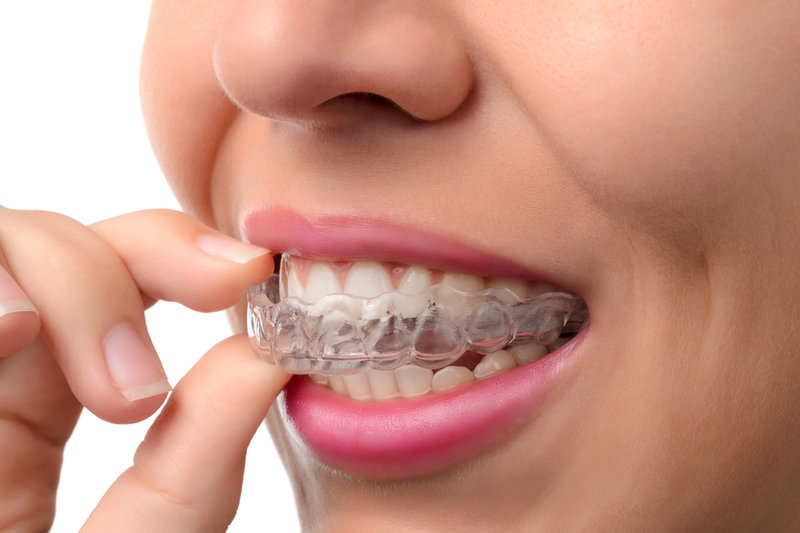
Woman wearing orthodontic silicone trainer. Invisible braces
We offer many different straightening methods at Belmar Orthodontics including Invisalign transparent aligners and traditional metal braces. In the past, traditional metal brackets were the only option for teeth straightening around. With the advancement of technology, we are now able to align the teeth with transparent aligners that work just as well as metal brackets. What are the differences between aligners and metal brackets? Which option is better for you when it comes to choosing between the two? We can answer all of your questions about Invisalign aligners and traditional metal braces and help you find the right straightening method for you.
Traditional Metal Braces
Metal braces are also known as “traditional” braces? Why? They’ve been around for decades and have proven time and time again that they work. Years ago they became the go-to option for orthodontic care and have stood the test of time. There have been tweaks here and there to make metal braces more modern, but overall, not much has changed. They are still the most popular option for braces among teenagers and the most economical choice for orthodontic care.
Metal braces consist of metal square brackets that are attached to the center of each tooth with a special type of bonding glue. This glue is strong enough that the brackets stay bonded to your teeth, but also versatile enough that the glue can be removed once treatment has come to an end. Metal braces have a thin wire that connects and goes through each bracket on the upper and lower jaw. In total, you will have two wires. These are known as “archwires” and they create an arch in your mouth that follows the natural curve of the jaw. Over time, these archwires will move the teeth into proper place so that they make the perfect, straight arch on the upper and lower jaw.
What Are Invisalign Transparent Aligners?
If you’ve looked into options for orthodontic care, you may already be familiar with Invisalign. This treatment option is a series of transparent aligners that slowly mold your teeth into proper position over time. Your doctor will scan your teeth using a digital scanning system that will then create 3D images of your teeth. You will then receive custom-made aligners made from Invisalign’s SmartTrack material. This material is transparent yet strong. The clear, removable design of these aligners renders this orthodontic treatment virtually invisible to others.
The best part is that Invisalign works well just like traditional metal braces do for shaping your smile. Simply change out your transparent aligners ever 1-2 weeks and watch how your smile changes over time. Adults and teenagers alike love this option for orthodontic care because of their ease of use Patients can eat, drink, and clean their teeth with ease. These aligners must be worn the majority of the day, but can be removed when needed for certain activities. Invisalign transparent aligners are more costly than metal braces, but you gain the benefits of easy use and cleaning, and the ability to straighten your teeth in secret.
Adult Orthodontics
Orthodontic care is not only for teenagers. About 25% of all braces wearers are adults, which is a higher percentage than it’s been in the past. Why is this? In decades and years past, people only had one choice when it came to braces: traditional metal braces. Some adults and teenagers avoid receiving braces although their smile needs them. Why? Because they don’t like the look of braces or they feel they are unattractive, distracting, or childish. Studies actually show that braces are quite the luxury to have. However, modern-day orthodontics offer treatment options everyone can be comfortable with.
Your Options
Options for orthodontic care include both traditional metal braces and Invisalign transparent aligners, but you can also choose
- Ceramic Braces – These are the same size and shape as metal braces. They function similarly to traditional metal brackets but they use ceramic brackets that are made to match the color of your teeth. Many patients love this cosmetic benefit of blending the braces to the teeth. Even the archwire can be made white! The ceramic has been shown to be much more resistant to staining and helps protect your smile from demineralization.
- Lingual Braces – Lingual braces are an amazing alternative to traditional metal braces. Lingual braces are a close cousin to metal braces. They actually look quite the same, except for the fact that the braces run along the inside of the teeth next to the tongue. You can achieve the same results as traditional orthodontics in a manner that is inconspicuous and undetectable. Dr. Hardy will make a custom mold of your teeth so that custom metal pieces can be made for each tooth back. These will then be attached snug to the inside of the tooth along with the brackets. An archwire will complete the braces and you can begin to experience the straightening power of lingual braces.
Keep Your Smile Straight
It’s never too late to correct orthodontic conditions you have. The benefits of adult orthodontics include: faster treatment time than former techniques, more discreet treatment options, correction of dental issues, increased confidence and even increased self esteem. When it comes to starting your journey to a straighter smile, we have options for you! To see if you are a great fit for ceramic braces or Incognito lingual braces, contact our Belmar Orthodontics office today at (303) 225-9016 for your free consultation. A straighter smile is just one call away!
Incognito Lingual Braces Vs. Traditional Metal Braces
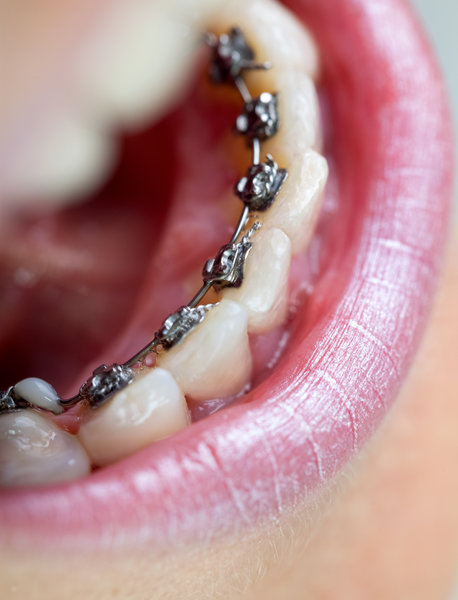
Young woman with lingual braces
There are many services we offer when it comes to straightening the teeth, including Incognito lingual braces and traditional metal braces. These two options are very similar, however, lingual braces are made slightly different than traditional metal braces because of where and how they are worn. Both will give you amazing straightening results and both are services we provide. What choice is right for you? Which is best for your budget and for your time? We can help you know the difference between Incognito lingual braces and traditional metal brackets and help you choose which option you’ll love the most. As always, with professional orthodontic care through Belmar Orthodontics, you can be sure you receive quality straightening power no matter what option you choose.
Investing In Braces
When you invest your time in braces, you are making an investment for the rest of your life. Your smile is one of the first physical features others see. Is that smile making an impression? We want all of our patients to have beautiful, healthy smiles. Why? Beautiful smiles are quite attractive to others. In studies, those with a straighter, more beautiful smile are seen as more attractive, trustworthy, confident and successful. Straighter smiles tell others that you take care of yourself.
When it comes to your health, a straighter smile can also help reduce your risk for tooth decay and gum disease. This is because the teeth are aligned and much easier to clean, especially in between the teeth. Plaque has a harder time staying stuck on the teeth and causing problems when the teeth are easier to clean. So when it comes to both aesthetic and health reasons, braces can really change your life! There are many options when it comes to choosing the right braces for you. Some of the most popular options in orthodontics are traditional metal braces and Incognito lingual braces.
Traditional Metal Braces
These are the braces you probably imagine when you think of braces. They are traditional because they’ve been around for decades and are proven to straighten your teeth effectively. Traditional metal braces are worn on the front of the teeth. In times past, the term “metal mouth” was a term some used to describe those who had these braces. However, studies have shown that braces have become a luxury in modern times.
Traditional metal braces are more popular than ever, especially among teenagers. Metal braces have also taken on a much smaller and sleeker design so you no longer have a mouth so full of metal. The best part about traditional metal braces (besides how well they work) is that they are also the least expensive option when it comes to orthodontic care. You can also dress up these braces with bright bands of color and express yourself the way you want.
Incognito Lingual Braces
Love the idea of metal braces but don’t exactly love how noticeable they are? We are excited to be able to offer our patients an alternative to traditional metal braces: hidden lingual braces. There are about 4.5 million Americans that currently wear braces. Of those, 25% are adults. The majority of the rest of braces wearers are teenagers. It is common for some adults and teenagers to avoid orthodontic treatment because they find metal braces to be unattractive or distracting. However, most people love to have straighter teeth. The solution? Incognito lingual braces!
With lingual braces, you can achieve the same results as traditional braces with a hidden treatment apparatus on the tongue-side of your teeth (by the tongue and palate). This is why they are referred to as “incognito” braces—they stay hidden (or incognito) as you straighten. We will take an impression of your teeth and make customized brackets fit perfectly to you. Lingual braces work much like traditional metal braces by slowly shifting the teeth into proper alignment. Unlike metal braces, each tooth must have its own installment of brackets and wires, as the lingual braces are shaped to each tooth back. Special training and technical expertise are needed to install these braces, and they do cost a bit more than traditional metal braces. However, you receive the trade-off of these braces being so undetectable.
Other Braces
There are more options than just traditional metal braces and Incognito lingual braces. We also offer:
- Invisalign – For those seeking an option that goes beyond Incognito braces, they can invest in Invisalign. This is a series of transparent aligners that are replaced every 1-2 weeks. They are virtually invisible and can be removed for eating, drinking, cleaning and sports.
- Ceramic Braces – Made from ceramic material, these white braces seek to have the functionality of traditional metal braces while blending into the teeth. Both the brackets and the wires can be made white so the braces are hard to see against the teeth.
Getting Your Braces
When it comes to receiving your braces, we want to give you options so that you truly enjoy your braces experience. Both traditional metal braces and lingual braces will work hard to straighten your smile. The dentists at Belmar Orthodontics have the expertise, training and experience to install both traditional metal braces or Incognito lingual braces to your smile. To start your orthodontic treatment with metal or lingual braces today, call our Belmar Orthodontics office today at (303) 225-9016!
Why Adult Braces Are So Important
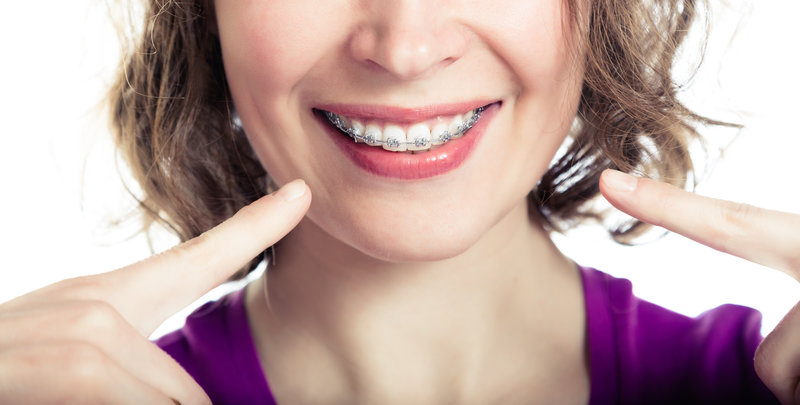
How important are adult braces? Not only do braces enhance your appearance, but they help prevent tooth decay and oral health problems. The American Dental Association tells us that braces are used to correct bite problems and malocclusion. Correcting these problems helps prevent oral health issues such as tooth decay, gum disease, jaw problems and even tooth loss. Proper orthodontic care goes beyond simply improving your oral health. Braces will give you added confidence that will boost performance in all facets of your life. Let us show you just how important braces are and why you should invest in them whether you are an adult or a child!
Braces for Children and Teens
About 75 percent of orthodontic patients are children and teens. Of that number, the majority opt to have traditional metal braces. Traditional metal braces are the most economic choice for orthodontic care if you are looking to improve your smile without breaking the bank. Children can receive braces as early as 7 or 8 years old depending on their needs. The adolescent years are the most common period for receiving braces when the head and mouth are still growing (especially the jaw). When children as young as 7 or 8 receive orthodontic treatment, it is usually to correct problems with alignment or bite that can become severe in later years. This early intervention ensures that teeth come in correctly in a child’s mouth and that the bite is aligned correctly. This will help correct problems with speech, biting, chewing, talking and even physical appearance.
Why Orthodontic Care Is Important
Orthodontic care during the adolescent years is generally used to correct alignment by straightening the teeth. Both bite correction and proper alignment is vitally important to oral health. When the teeth are crooked, problems such as tooth decay and gum disease can easily set in. This is because food becomes trapped in the teeth when you eat and is much harder to remove when the teeth are crooked. Gums can become irritated when plaque sits on the teeth for too long. Over time, plaque-infested gums can become red, swollen and can bleed easily–especially when flossing. Gums can even begin to recede to the point where the teeth fall out. Recession occurs more frequently with teeth that are crooked and harder to clean. Teeth that have been straightened through orthodontic care avoid some of these challenges.
When bite is misaligned, the teeth can come in crooked in a child. Patients may have overbite, underbite, crossbite, openbite or malocclusion. All of these types of misaligned bites will interfere with eating and speaking as well as the physical appearance of the mouth and face. This is because many of the teeth overlap one another abnormally or one jaw protrudes more than the other. Orthodontic care through braces for children and adult braces can correct these problems. Orthodontic treatment through adolescent and adult braces can help ensure that there is enough space for all the teeth to sit comfortably in the mouth.
Other Reasons to Invest in Braces
Are braces something you should invest in? The answer is yes! Whether you seek adult braces or braces for children and teens, you are making a decision that has far-reaching effects. The majority of people will experience crooked teeth at some point. What you decide to do about it is up to you.
Braces—even adult braces—are actually quite desirable today according to reports by the Los Angeles Times, The Washington Post, The Wall Street Journal and more. The amount of adults wearing braces rose 24% between 1989 and 2008 alone and that number has continued to rise. Why? Braces have become more affordable and more attractive. Insurance even covers part of the cost for many patients. Braces are also more comfortable than they were in the past and there are more options for patients seeking orthodontic treatment. The social benefits of braces alone draw people in as well.
Studies About Adult Braces
There have been many studies done about the importance of braces. Invisalign conducted one such study several years ago that recorded more than 1000 responses by pedestrians on the street. These pedestrians were asked to choose from two pictures of people placed side-by-side. Who would they trust more? Who seemed more confident? Respondents did not not beforehand that the comparison was between people with straight smiles and people with crooked smiles. From that study, it was found that those with straighter smiles were perceived as more confident, more successful, more attractive and up to 70% more trustworthy. All from a better, straighter smile!
Proper orthodontic care can also get you ahead when it comes to job interviews and new opportunities. Because a straighter, more beautiful smile has been shown to exude all of the characteristics above, those traits are also perceived in job interviews and during first impressions. Adult braces can help you land that job you’ve wanted and can help you get ahead professionally.
Your Options at Belmar Orthodontics
Traditional metal braces are just that: traditional. This is the most common option chosen by patients when selecting what type of orthodontic care they want. This choice is often popular with children and many teens and has proven through the years to provide exceptional straightening power. Adults and teenagers alike will sometimes avoid needed orthodontic treatment because they find traditional metal braces to be distracting or unattractive. Because of this, we provide you other options when it comes to straightening those pearly whites. These include:
- Incognito Lingual Braces: Metal braces attached to the inside of the teeth that stay hidden.
- Invisalign Transparent Aligners: Transparent aligners that are changed every few weeks to shape your teeth into proper alignment.
- Ceramic Clear Braces: The look of traditional metal brackets made in ceramic form. Both the brackets and wires can be made white to match your natural teeth.
At Belmar Orthodontics, we do all that we can to ensure your mouth stays healthy and your smile bright. Our success is dependent on your success. This is why we offer you so many options when it comes to straightening children’s teeth or investing in adult braces. To learn more about child and adult braces, call our office today at (303) 225-9016!

